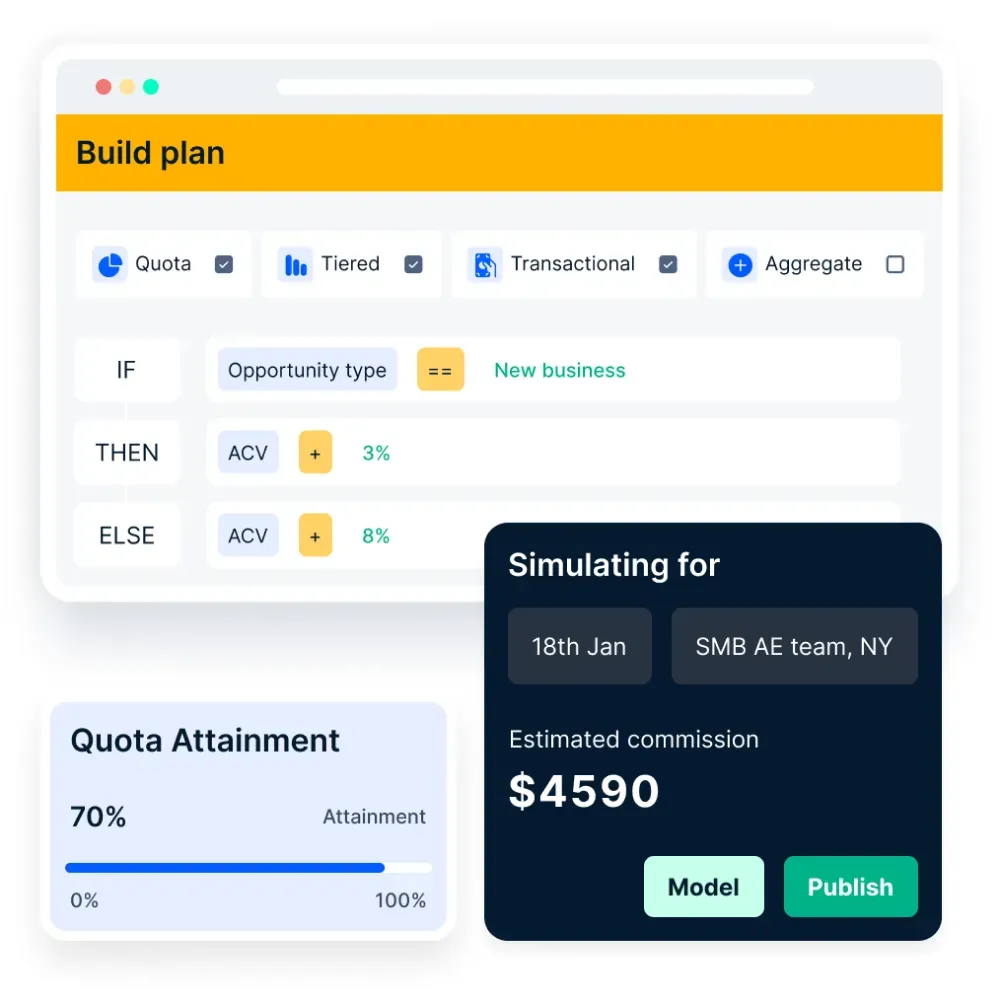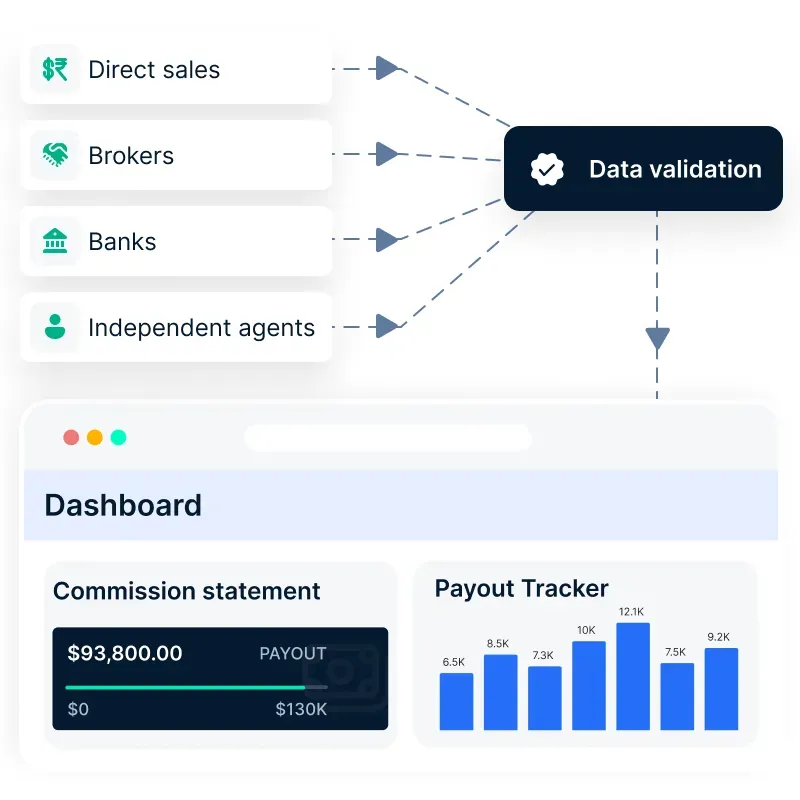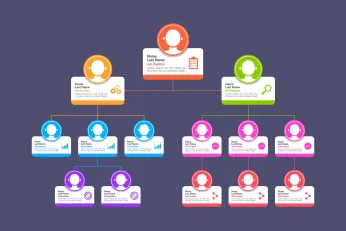On this page
A well-structured sales incentive compensation program is a powerful tool for driving revenue growth and enhancing sales team performance. When designed effectively, these programs align sales behaviors with business objectives, motivating reps to exceed targets while ensuring long-term profitability. However, simply offering incentives is not enough—following sales incentive programs best practices is crucial to maintaining engagement and productivity.
Companies that implement best practices in sales incentive plan design create transparent, data-driven compensation structures that reward high performance while promoting sustainable sales growth. Research shows that engaged and motivated sales teams contribute to higher profitability and reduced turnover, making strategic incentive planning a business necessity. This blog will share best practices in sales incentive planning and compensation.
What is a sales incentive compensation?
Incentive compensation is additional money sales representatives earn on top of their regular base salary and bonuses whenever they close a deal or achieve a specific business objective.
A representative might be earning a commission or a bonus, but mostly this is given out as cash and forms a part of his existing compensation plan.
On the other hand, sales incentive compensation is designed to stimulate certain behaviors in the sales teams, which undoubtedly enables higher sales and serves as a tool for motivation and recognition.
It has an intrinsic value that extends beyond monetary worth. Recipients view this compensation as celebratory, with a sense of appreciation and recognition, making them more memorable.
This incentive can take many forms and may include noncash rewards like prizes, tickets, annual family holiday packages, team holidays, etc. With a properly designed and delivered sales incentive compensation plan, salespeople maximize their rewards, and the organization maximizes revenue.
The best sales incentive plan for your organization should be simple enough for the sales reps to understand its working so that they take necessary actions to hit their goals.
How does incentive compensation management work?
Incentive compensation management automates commission and bonus calculations, providing real-time tracking for sales reps to monitor earnings and payouts. The right system simplifies plan administration, making updates and adjustments seamless.
For effective implementation, incentive programs must align with business goals and sales strategies. A well-designed plan ensures that variable compensation reflects performance, driving motivation and results. Integrating this software with a sales CRM enhances visibility, helping reps understand their earnings and performance metrics.
Managing incentive compensation manually is complex and prone to errors, leading to miscalculations, payment delays, and disengaged sales teams. Compass automates the entire incentive compensation management (ICM) process, ensuring real-time tracking, accurate payouts, and seamless plan administration.

With Compass’s no-code platform, businesses can design, publish, and manage incentive plans for any role without requiring technical expertise. Additionally, hierarchy-based approval workflows ensure that earnings approvals, escalations, and disputes are handled efficiently, eliminating miscommunication between teams.
Why is incentive compensation management important?
Effective incentive compensation management is key to driving performance and retention. It ensures fair, transparent pay structures that align team behavior with company objectives. By automating processes, businesses reduce errors and save time.
- Aligns sales efforts with company objectives.
- Boosts morale and retention with clear, fair compensation.
- Reduces errors and saves time by automating manual processes.
- Attracts top talent with structured, competitive pay plans.
- Enhances forecasting and financial planning through accurate tracking.
Without efficient compensation tracking, businesses risk errors, inefficiencies, and disengaged sales teams.
Errors and inefficiencies in incentive management can lead to financial losses, disengaged employees, and disputes. Compass eliminates manual miscalculations and ensures error-free payouts by automating commission tracking.
Its flexible data management seamlessly integrates with leading CRMs, ERPs, HRMs, and Payroll systems like HubSpot, SAP S/4HANA, Workday, Zuora, QuickBooks, Salesforce, Zoho CRM, Sage, and Google Sheets, providing a fully connected and automated workflow.

By leveraging real-time tracking and automated calculations, Compass helps businesses improve accuracy, enhance transparency, and reduce administrative overhead.
Specific types of incentive compensation
Organizations use various types of incentive compensation to drive performance and engagement. Here are some common examples:
- Performance-based bonuses reward employees for achieving specific goals. For example, a marketing manager may receive a bonus for increasing website traffic by 20% in a quarter.
- Restricted stock units (RSUs) grant company stock that vests over time. A tech company might offer RSUs to software engineers as part of their compensation package to encourage long-term commitment.
- Profit-sharing bonuses distribute a portion of company profits to employees. A manufacturing firm, for instance, might give annual bonuses based on company earnings to all employees.
- Commission-based pay provides a percentage of sales revenue. A car salesperson earning 5% commission on every vehicle sold is a common example of sales incentive compensation.
Some organizations use a single incentive type, while others combine multiple forms. Finding the right mix ensures employees stay motivated and aligned with company goals.
How are sales incentive compensation plans designed?
Typically, in most organizations, sales leadership and sales operations teams create and manage the sales incentive compensation plan. They take valuable inputs from functions like finance, marketing, IT, and HR on other important parameters aligned with organizational goals and sales metrics. During the designing and adoption process, the plan may be revised multiple times and re-assessed basis disputes on buy-in from the wider sales team, business environment, and overall effectiveness.
With so many metrics to track, complex calculations, the inclusion of a variety of customizations, designing an incentive compensation is no doubt a daunting task. Add to it the need for real-time visibility, easy to understand dashboards, and insights, the incentive design team is in for a tough ride. It helps to take note of these three basic principles mentioned below while designing an incentive compensation plan:
Organizational principles
These principles are about linking incentive plans to larger company goals. It involves
- Allotting adequate weightage to each goal and measuring them accurately
- Including flexibility to adapt the incentive plan to any changes in the market, or change in business objectives
Motivational principles
These principles link incentive plans to personalization in value and the role in the organization. These may include
- Providing incentives that are more emotional (sense of achievement, social status) than just utilitarian
- Using predictive algorithms to estimate individual sales targets than just the same percentage increase for everyone
Behavioral principles
These principles link incentive plans to encourage desired behavior in individuals and teams. It leads to
- Incentivising for improvements in quality of leads rather than just chasing target numbers
- Metrics like decrease in customer complaints as compared to the last quarter
Once finalized, the sales incentives compensation plan needs to be communicated well within the organization. Poor communication of a great plan is worse than good communication of a mediocre plan. There is a need for online training, FAQ documents, and an open channel for answering doubts of the sales team once the rollout of a sales incentive plan is done.
Since high cost is involved in any incentive compensation and its great potential to drive sales behavior, maximizing Return on Investment on Incentive compensation is critical for businesses. But ROI on incentive plans is a higher financial return on capital expenditure but an overall impact on the organization, ranging from strategically motivated sales teams to lower attrition to timely pay-outs and even better business predictions.
It is not an easy task to calculate the ROI that an incentive plan generates. To calculate in monetary terms, you can look at an increase in revenue (and/or market share gained, number of customers acquired, inventory turnover rates, etc.) and subtract the overall cost of implementing and administering the program. But for non-monetary impact, you need to set the efficacy measurement metrics at the beginning while creating your incentive plan. For example, some intangible factors like training adoption, absenteeism, employee satisfaction scores in surveys, cost of losing or gaining a new customer can provide the perceived value of the incentive plan and impact salespeople's motivation.
Many studies done by Incentive Research Foundation indicate that there is absolutely no doubt that incentives need to be designed around your best assets- people. When people identify with the organization and feel a sense of belonging and being heard, they are intrinsically motivated to perform well in their duties and place higher value and a deeper appreciation for incentive compensation plans' rewards.
Sales best practices to increase ROI for sales incentive compensation
To increase your ROI for Sales Incentive Compensation, here are four sales best practices to follow. Let’s explore each of these sales best practices in detail.
1. Automate to eliminate errors
It is not an easy task to design an incentive compensation plan. With many roles to assess, large calculations, time spent gathering information across teams, managing digital trail of changes and events, etc., the manual process is bound to be erroneous.
Inaccuracy in calculations is a double-edged sword – in both cases of overpayment and underpayment of compensation, the business pays a hefty price. Overpayment leads to direct financial loss for the organization and a reduction in ROI. In contrast, underpayment leads to reduced employee trust, decreased sales performance, and even cost of the legal battle if an employee files a lawsuit for inaccurate payment!
When sales representatives doubt the payments being made to them, their time, which ideally should be spent selling and bringing more business, is wasted on shadow accounting. Many organizations provide automation of sales incentive plans and can help make the process efficient. Consider investing in an automated incentive compensation management solution if you plan to keep your sales teams motivated and achieve accuracy in payments.
Compass eliminates these errors with automated commission calculations, ensuring fair compensation and eliminating disputes. Sales teams can focus on selling rather than shadow accounting, increasing overall productivity.
2. Bring operational efficiency to reduce cost
When a sales incentive compensation system is automated, there is a reduction in the number of resources needed to make the manual calculations and reduce calculation time, which otherwise extends to many days each month.
Now, by automating workflows, there is an improvement in the system's efficiency with reduced time spent on data entry, lower risk of potential down-the-line disputes, and cost-savings in terms of the requirement of lesser resources.
Compass streamlines the sales compensation process, reducing manual workload, decreasing calculation time, and eliminating administrative inefficiencies. By automating data entry and workflows, organizations lower resource costs while improving accuracy and speed.
3. Use digital insights to boost performance
Manual incentive calculations cannot provide advanced digital insights both to sales leaders as well as sales reps. With a digital representation of his personalized performance data and variable compensation on an automated sales incentive compensation model, a sales representative can easily understand the results, so he invests time improving his metrics and is more satisfied and less likely to leave the organization. Sales leaders have better insights in struggling areas for their sales reps and can coach their marginal performers better and personalize their coaching, leading to improved performance.
In a competitive world, companies shouldn’t ignore digital tools that their competitors are benefitting from. An automated sales incentive planning and insights tool is one such tool. This tool provides valuable data insights on the overall business, which helps in better future planning and leads to an increase in sales numbers.
When a large sum of money is already being spent on sales reps compensation, it is imperative to benchmark your incentive and sales compensation plans with competitors to understand if you are getting an adequate return on the investment and learn best practices. Digital insights enable a quick and easy comparative analysis to apply learnings to business in no time.
Compass provides real-time digital insights into sales performance, quota attainment, and commission effectiveness.
Predictive analytics helps leaders set realistic and personalized sales targets.
Benchmarking tools compare incentive structures with industry standards, allowing for optimization.
Personalized dashboards give sales reps a clear view of their earnings, goals, and commission trends.
By adopting Compass’s data analytics, organizations gain better visibility into performance trends and ensure their incentive plans drive real revenue growth.
4. Improve timeliness
Your sales incentive compensation program serves as a single version of truth for sales information on calculations scattered across the organization. It helps provide an accurate financial picture to make better decisions for the business.
A digitized incentive compensation program automates complex computations, makes access to information faster, sharing information cross-functionally easier, and enabling agility in decision-making. The finance team doesn’t need to wait till the end of the month to get compensation cost data, but it’s now available on-demand. This increases forecasting speed and accuracy for organizations.
No one wants to invest cost in incentive compensation and still be at a disadvantage. Advanced incentive compensation technologies enable organizations to better ROI on this huge expense, keep their sales force engaged and motivated with adequate incentives, and align sales strategy for business growth. They enable fact-based clarity and employ algorithms that learn as more data is being entered, enabling better future predictions.
Consider using an automated sales incentive compensation program for your organization if you haven’t done it already. You’ll live to see the many beneficial results it can give.
Compass automates complex compensation calculations and provides instant access to commission data, ensuring timely and accurate payments.
Finance teams can access on-demand compensation reports instead of waiting until the end of the month, improving forecasting accuracy and business decision-making speed.
5. Automate to Eliminate Errors
Designing an incentive compensation plan is a complex task. With multiple roles to assess, large calculations, data gathering across teams, and managing a digital trail of changes, a manual process is prone to errors.
Inaccurate calculations lead to overpayment or underpayment, both of which harm the business. Overpayment results in financial losses and reduced ROI, while underpayment diminishes employee trust, decreases performance, and could even lead to legal disputes.
Sales representatives who question their payments waste valuable selling time on shadow accounting. Investing in an automated incentive compensation management solution ensures accuracy, reduces disputes, and keeps sales teams motivated.
Compass eliminates errors through automated commission calculations, ensuring fair compensation and reducing disputes. This allows sales teams to focus on selling rather than verifying payments, ultimately improving productivity.
6. Bring Operational Efficiency to Reduce Costs
Automating the sales incentive compensation system reduces resource allocation for manual calculations and significantly cuts down processing time. By automating workflows, organizations improve efficiency, lower the risk of disputes, and reduce costs associated with administrative work.
Compass streamlines the sales compensation process by reducing manual workload, decreasing calculation time, and eliminating inefficiencies. Automation lowers resource costs while improving accuracy and speed.
7. Improve Timeliness
An automated incentive compensation program provides real-time insights into financial data, facilitating better business decision-making. By eliminating delays in accessing compensation cost data, organizations can improve forecasting speed and accuracy.
Compass automates complex compensation calculations and provides instant access to commission data, ensuring timely and accurate payments. Finance teams can access compensation reports on demand, improving forecasting accuracy and decision-making speed.
Case Study: Automating Sales Commission for Asia’s Largest CNC Machine Manufacturer
The application of this best practice can be evident in the case study below.
Challenge
A leading CNC machine manufacturer with 32+ global sales locations faced challenges in managing its sales commission process. The company needed a solution to:
- Provide real-time visibility into incentive calculations for sales reps.
- Reduce manual effort in commission processing.
- Eliminate reliance on sales leaders for handling commissions manually.
Solution: Compass Sales Commission Management
To address these challenges, the company implemented Compass, which:
- Automated commission calculations with real-time tracking.
- Provided gamification features (leaderboards, scorecards, quizzes) to increase engagement.
- Enabled workflow automation with approval mechanisms to reduce errors and delays.
Impact & Results
By leveraging Compass’s automation and engagement tools, the company achieved:
- 20% increase in quota attainment within 90 days.
- 22% increase in incentive program qualifiers.
- 73% higher platform adoption among sales teams.
- Improved payout accuracy and reduced dependency on sales leaders for manual commission handling.
This case study highlights how Compass transformed incentive compensation management, ensuring accuracy, efficiency, and higher sales engagement, in short by implementing sales incentive compensation best practices.
Conclusion
Implementing sales incentive compensation best practices ensures a motivated sales force, higher revenue, and long-term business growth. By leveraging automation, digital insights, and strategic planning, companies can create transparent, results-driven compensation structures.
A well-structured incentive plan not only improves sales performance but also enhances employee engagement and retention. To stay competitive, businesses must continuously optimize their incentive programs, align them with evolving goals, and leverage technology for seamless execution. To stay ahead of the competition, schedule a call now with Compass!
FAQ's
What are the three sales compensation methods?
The three main sales compensation methods are:
- Salary-only: Fixed pay without performance-based incentives.
- Commission-only: Pay is entirely based on sales performance.
Base salary + commission: A combination of fixed salary and variable commissions based on sales results, offering stability and motivation.
What is a good sales incentive plan?
A good sales incentive plan is clear, motivating, and aligned with company objectives. It should reward key sales behaviors, offer competitive compensation, and include achievable yet challenging targets to drive performance and revenue growth.
What is a 70/30 compensation plan?
A 70/30 compensation plan means that 70% of a salesperson’s earnings come from a fixed base salary, while 30% is variable pay based on performance (commissions, bonuses, or incentives). This structure provides financial stability while still incentivizing high performance.
What is the best sales compensation plan?
The best sales compensation plan aligns with business goals, motivates sales reps, and balances fixed and variable pay. It should be performance-driven, data-backed, and structured to reward both individual and team achievements while ensuring long-term profitability.













